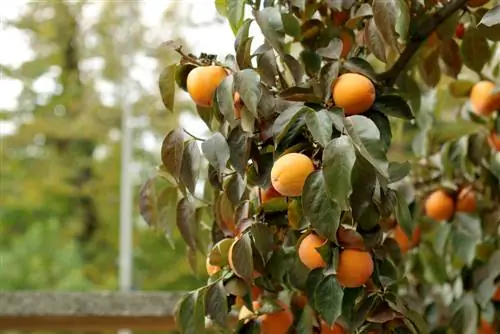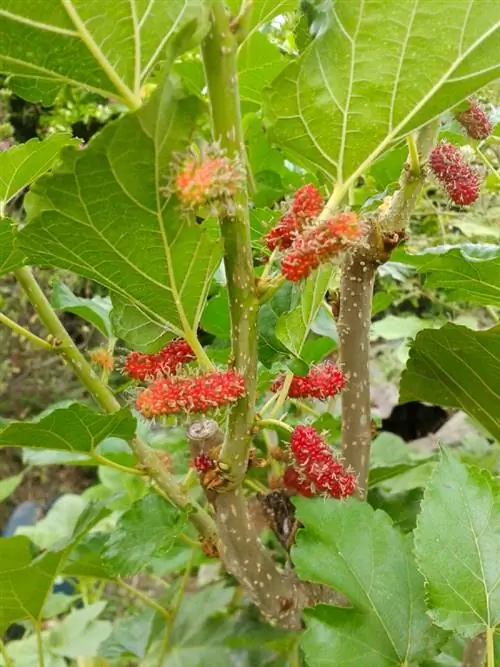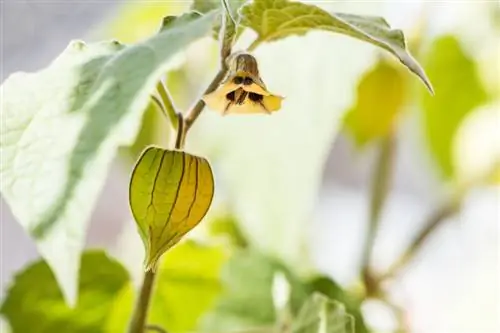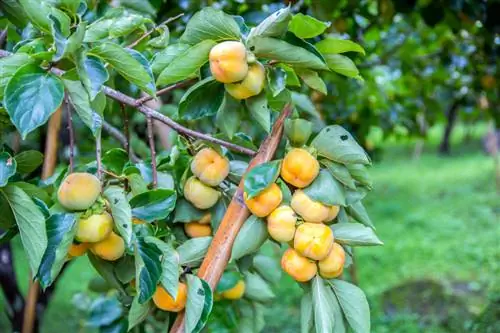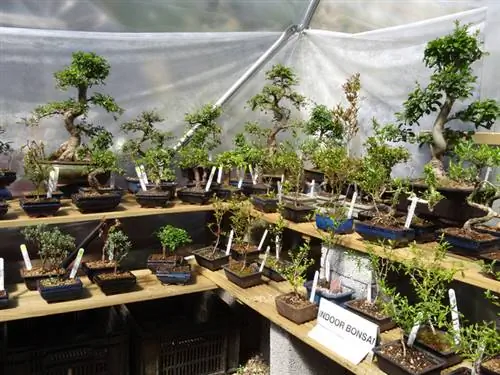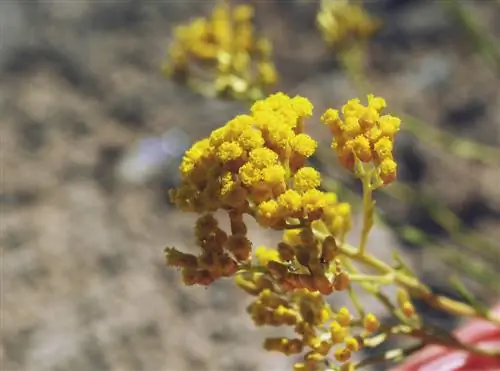- Author admin [email protected].
- Public 2023-12-25 17:45.
- Last modified 2025-01-23 11:21.
Persimmons can now be bought in almost all supermarkets in our part of the world. In recent years it has become a real trend fruit. If you have a taste for it and want to distance yourself from imported fruits, you can also grow your own persimmon tree!
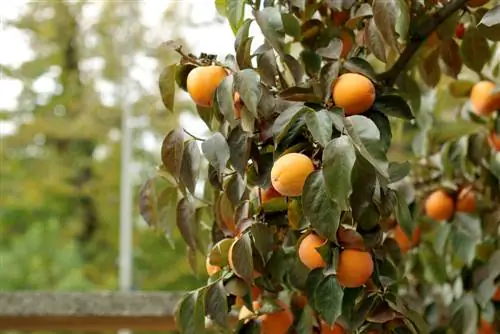
What should you know about the persimmon tree?
The persimmon tree (Diospyros kaki) is a fruit tree from China that thrives in mild areas. It resembles an apple tree in habit, is frost hardy and easy to care for. The vitamin-rich fruits ripen in October-November and taste similar to pears or apricots. Popular varieties include 'Hana Fuyu', 'Rojo Brillante' and 'Vaniglia'.
Origin
The persimmon tree - also called persimmon plum or persimmon plum - belongs to the genus Diospyros within the ebony family, which means something like “fruit of the gods” in German. There is perhaps something divine about the round, tomato-like looking fruit in that it has a pleasantly sweet taste and, not least for this reason, has been valued and cultivated for over two millennia - originally in the Far East, especially in China.
In general, the persimmon tree thrives quite well here in Central Europe, whose climate is not significantly different - mild areas that are not particularly at risk of frost are an advantage.
To remember:
- Persimmon tree comes from China
- Valued there as a fruit tree for over 2000 years
- Grows well here, especially in mild areas
Growth
In terms of habit, the persimmon tree closely resembles an apple tree with its low trunk and rather crouched, rounded crown. When conditions are favorable, it reaches heights of around 8 meters. Its bark is smooth and reddish brown in color.
Growth characteristics in keywords:
- Habitus apple tree-like
- In favorable conditions, growth heights of up to 8 meters
- Smooth, reddish-brown bark
leaves
Alternate oval to lanceolate, tapered leaves appear on the branches, which in turn are not dissimilar to those of the apple tree. However, they are slightly larger, have a firmer, smoother texture and are darker in color. In addition, in contrast to apple tree leaves, they are not matt, but clearly shiny. In autumn they turn yellow to orange-red.
To remember:
- Leaves also similar to apple trees, but slightly larger, firmer, smoother and darker
- Glossy surface
- Yellow to orange-red autumn color
Flowers
The wild form of the persimmon tree is either monoecious or dioecious, meaning it either produces both female and male flowers or is purely unisexual. In monoecious individuals, the male and female flowers are distributed in separate groups. The four radially symmetrical petals have a creamy to yellowish color, are raised like a cup and rolled far outwards at the tips. On the female flowers they sit above four large, green sepals, which also remain attached to the formed fruit. Overall, the flowers have a diameter of around 2 to 2 ½ centimeters.
Fertilization of the female flowers is not necessary for fruit formation, they are self-fertilizing. Male flowers are fertilized primarily by insects.
Flower properties at a glance:
- Persimmon tree individuals are monoecious or dioecious
- Flowers 2 to 2 ½ cm tall
- Four creamy-yellow, cup-like petals, rolled far outwards
- Female flowers sit above 4 green sepals
- Flowering time
The flowers open in late spring, around May, and last until June.
Fruit
The coveted divine fruit ripens quite late in the year, around October or November. It is often compared to tomatoes in appearance, especially because of the rounded shape and smooth skin. However, their color is lighter, orange to yellowish. They can weigh up to half a kilo. The taste is reminiscent of pears or apricots and is often halved like kiwis and spooned out of the shell. The fruits are extremely rich in vitamins and they also contain a lot of tannins, which have an astringent effect and leave a furry feeling in the mouth, especially when the fruit is still rather unripe.
To remember:
- Fruit ripening in October to November
- Externally similar to large tomatoes
- Color yellowish orange
- Taste pear-like to apricot-like
- Contains vitamins and tannins
Which location is suitable?
Kaki trees love the warmth. If you want to get a specimen into your garden, you have better chances if you live in a mild (wine-growing) area. A large proportion of imported supermarket fruit comes from Spanish growing areas. So give your persimmon tree a place that is as cozy as possible, where it collects a lot of heat from the sun and where there are no strong winds. A lot of sun is also helpful for pleasantly sweet, aromatic fruit development. Although it is partially frost hardy, the tree should not get too much frost - an exposed area should therefore be avoided.
A persimmon tree can be planted outdoors from around the 3rd to 4th year of life. The older the individual, the more frost tolerant it is.
Location requirements in keywords:
- As warm, sunny and sheltered from the wind as possible
- Not too exposed
- Planting outdoors from the 3rd to 4th year of life
Planting timeAlways plant a persimmon tree in spring so that it can establish itself in its location over the warm half of the year.
What soil does the plant need?
The planting soil for a persimmon tree should be as rich in humus and nutrients as possible. It is best to add a good portion of mature compost to the substrate when planting. You should also ensure a balanced relationship between drainage and drainage by adding a clay component to the soil and incorporating effective drainage in the form of a layer of gravel. If you initially plant a young persimmon tree in a container, pay particular attention to good drainage, including through several drainage holes in the bottom of the container.
Fertilize the persimmon tree once per spring, especially in the first few years, with good compost.
Substrate requirements at a glance:
- Rich in nutrients and humus
- Balanced ratio between water- and nutrient-retaining clay content and drainage that promotes drainage
- Fertilize with mature compost in the first spring
Watering the persimmon tree
In summer and into the fruiting season, the persimmon tree needs a relatively large amount of water. During this period, water it regularly and extensively, especially during the first few years. The persimmon tree likes soft, low-lime water, preferably from the rain barrel.
Cut the persimmon tree correctly
In order to produce lots of fruit, the persimmon tree does not necessarily need regular pruning. Even without pruning care, it is quite fruit-producing. He plants the fruit on the previous year's wood. However, it is still cut-friendly and can be kept in shape for the eye. In order to obtain a balanced, richly branched crown, you should train it to form a central shoot with four to five side shoots every year at the end of winter. To do this, shorten all long, horny shoots down to the base. A standard or trellis training is also possible.
- Pruning not absolutely necessary to preserve lush fruit
- Form education for the optics but quite possible
- To do this, shorten long annual shoots regularly (radically)
- High-stem or espalier training is also possible
read more
Propagation
Kaki trees, like most fruit trees, are propagated through grafting.
Diseases/Pests
Kaki trees are fortunately quite resistant to disease. However, pests can feast on it from time to time - but these include well-known and quite easy-to-control candidates such as aphids, scale insects and spider mites.
Aphids
You can easily recognize an aphid infestation by the sticky honeydew coating over the leaves that the insects excrete. Sooty fungi can also settle under the honeydew, forming a blackish lawn. In dry, warm weather in early summer, aphids can multiply explosively. Above all, make sure you water them adequately. To prevent this, you should also pay attention to favorable environmental conditions, i.e. a warm, sunny location, as species-rich, natural garden culture as possible (which attracts beneficial insects) and only organic, moderate fertilization.
If the tree is infested with aphids, only spray it with a strong jet of water if possible. Cut out and dispose of severely damaged shoot tips. Preparations based on neem oil are also an effective and biologically responsible remedy.
Scale insects
Similar to aphids, scale insects suck the sap of their host plant and excrete sticky honeydew, which in turn promotes the formation of sooty mold fungi.
In addition to promoting beneficial insects in the garden, you can also prevent scale insect infestation through protective trunk care. The bark surface is smoothed by removing loose pieces of bark and then sealed with a white coat of trunk paint. This prevents larvae from overwintering under the bark and at the same time protects the tree from frost damage.
It can be combated by spraying it or by applying a mixture of paraffin and rapeseed oil.
Spider mites
These pests get their name from the fine webs with which they cover the leaves and twigs of their host plant. As the infestation progresses, speckle-like spots appear on the leaves, which are caused by the mites' sucking sites. As the infection progresses, the leaves gradually curl up, die and are shed. Spider mites pose an additional danger in fruit trees because they can transmit some viral diseases.
Careful trunk care is also particularly effective as a preventive measure against spider mite infestation.
Varieties
With Diospyros kaki, a distinction is made between the cultivated forms honey apple or persimmon, the yellower, more elongated persimmon and the also yellower, flatter Sharon fruit. But here we concentrate on the varieties of persimmons.
Persimmon 'Hana Fuyu'
The 'Hana Fuyu' variety produces very tasty fruits that ripen comparatively early in the year, namely in mid-autumn. The coloring of the foliage before the fruit ripens is also particularly spectacular, so this variety also offers something to the eye. However, it is slightly more sensitive to frost than other variants; the thermometer should not fall below -16°C.
Kaki Rojo Brillante
The Rojo Brillante is the variety most imported to our latitudes. Their large fruits are very aromatic and are produced in generous abundance. The tree is relatively frost hardy.
Kaki Vaniglia
The fruits of the Kaki Vaniglia taste pleasantly sweet and are ripe from the end of October to November. However, they can also be harvested earlier and left to ripen indoors. The tree is vigorous and forms a slightly larger crown than its counterparts.

